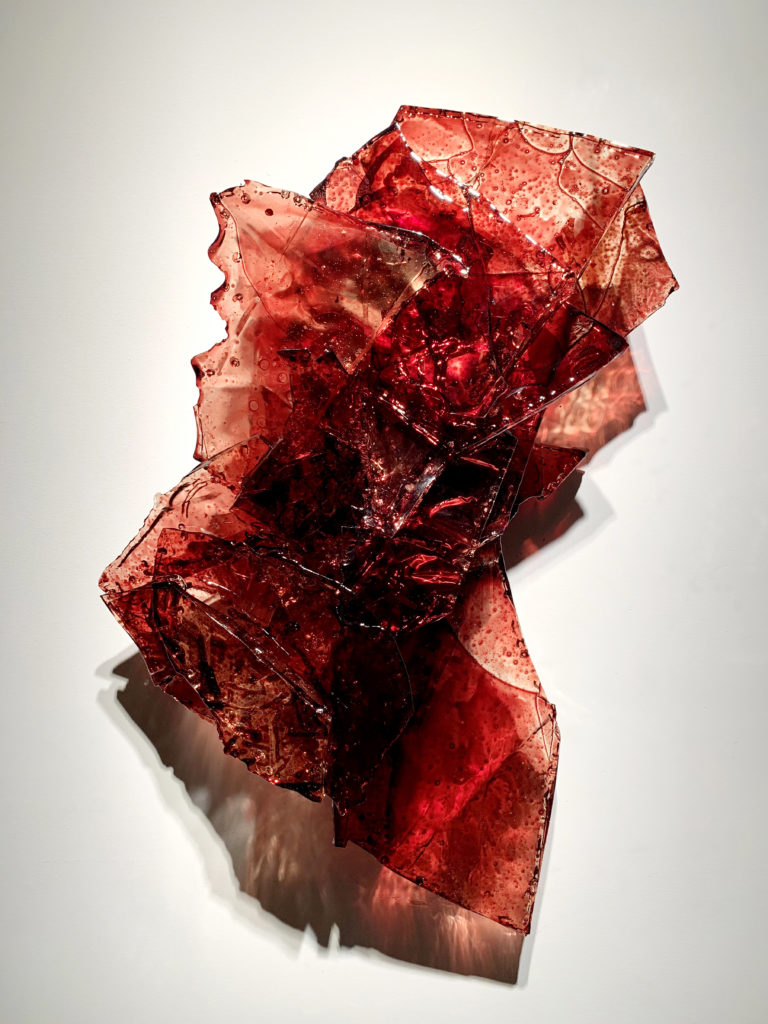In this regular feature, contemporary artists from around the world describe their art practice, spirituality, and current work.
Queens, New York
Image: Do you see yourself as religious, and if so, has this self-definition influenced your work?
Jordan Eagles: I am not religious. I believe in a universal energy that is part of everything that exists, and I consider most of my work to be spiritual. I was raised in a household with art and texts from many cultures and religions. I also find spirituality in science. I am amazed that cellular details seen through a microscope can often look like telescopic images of the cosmos. The connections between body, spirit, energy, and regeneration are fundamental to my work.
Image: Are there any questions you find yourself struggling with over and over again?
JE: I would call them creative challenges. Since my practice is rooted in a few primary materials, especially blood and resin, I’m always trying to push in new directions, both conceptually and aesthetically. I’m constantly asking questions about reinvention while maintaining integrity when it comes to core materials and issues, as well as providing information and entry points for crucial policy conversations.

Jordan Eagles. Untitled (Shard), 2019. Blood, UV resin. 34 x 24 x 6 inches.
Image: Do you notice that people respond differently to your work in different settings, in a church as opposed to a gallery, say?
JE: Absolutely. Architecture and context can certainly affect how audiences interact with the sculptures and installations. There is a tangible history and collective consciousness that you can feel inside spiritual spaces. Blood also emits a powerful energy and has deep roots in religious iconography and myths. Both are so sacred that there is a natural synergy between the materials I use and spiritual venues.
People also often enter sacred spaces at a slower, quieter pace, with a sense of anticipatory contemplation. This can be ideal for reflecting on art and ideas. When I shared my works at Trinity Wall Street in New York City and Guy’s Chapel in London, I had unique experiences with a lot of positive feedback from the congregations.
Image: What has been the most surprising response to your work?
JE: I’ve had many unusual responses over the years—someone almost fainted, and I’ve seen people cry in front of paintings. But one of the most meaningful was when a collector couple hung a large work above their bed because they wanted to conceive their first child underneath it. It was very special to me that the artwork would be associated with the creation of life in this highly personal way.
Blood can evoke a lot of emotions, and sometimes there can be a frightening association. However, because I treat blood as a life-force, with a unique method of preservation, the response I get most often is from people who are surprised how beautiful blood can be when presented in this format.
Image: How do you negotiate the boundary between art and activism?
JE: I aim to inspire conversations around equality and touch audiences beyond the art world, with the expectation that discriminatory policies can eventually be changed. The projects take the form of collaboration—which is key. Many individuals support and participate in the work, from medical supervisors to blood donors. These projects can only be accomplished through people coming together and expressing our common humanity.

Eagles working in the studio.
Image: How are you thinking about your work in the midst of a pandemic?
JE: A lot of my work resembles cellular growth, planetary bodies, supernovas and explosions of energy. A corona is the outermost part of the sun’s atmosphere, made up of the plasma that surrounds the sun and other stars and expands millions of miles into outer space. It has been strange to look at a word—corona—that has so rapidly infiltrated our culture, representing disease, suffering, and death, and think about its other connotations.
In all my projects that involve human blood, I create additional sculptures out of the blood bags, collection tubes, latex gloves, protective gear, and anything that comes in contact with the blood during the art-making process—all of which is preserved in resin. The current shortage of protective gear for medical workers is reminding me of these works and making me think about how we might relate to these materials going forward.
Most importantly, as our society deals with Covid-19, I am reading about the immediate need for blood donors because of shortages due to the pandemic. This reaffirms the need for the US government to update its discriminatory blood donation policy to allow gay and bisexual men to donate blood and participate in saving lives without any deferral period based on gender or sexual orientation.
Image: Where can people see your work in 2020?
JE: I have work hanging in a few museums, but those museums are closed now. My work is on my website, and I share process images on Instagram. From June 10 to December 1, 2020, I’ll be presenting a virtual exhibition, Can You Save Superman? at the Leslie-Lohman Museum of Art, curated by Eric Shiner. I hope we can beat this virus soon and get back to being physically close to one another again. There is nothing like experiencing art in person with friends and loved ones.
Jordan Eagles is a New York–based artist who has been exploring the aesthetics and ethics of blood as an artistic medium since the late nineties. His website is www.jordaneagles.com, and his Instagram handle is @jordaneagles.










